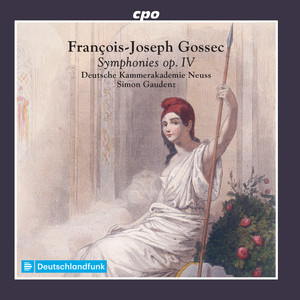
Gossec: Symphonies, Op. 4 Nos. 1-6
- 指挥: Simon Gaudenz
- 乐团: Deutsche Kammerakademie Neuss
- 作曲: Unknown Artist
- 发行时间:2019-08-02
- 唱片公司:CPO
- 唱片编号:555263-2
- 歌曲
- 时长
-
作曲家:François-Joseph Gossec
-
作品集:Symphony op. IV No. 1 in D major
-
作品集:Symphony op. IV No. 2 in E major
-
作品集:Symphony op. IV No. 3 in F major
-
作品集:Symphony op. IV No. 4 in C major
-
作品集:Symphony op. IV No. 5 in E major "Pastorella"
-
作品集:Symphony op. iV No. 6 in Dminor
简介
Today the composer Francois-Joseph Gossec is closely associated with the music of the French Revolution. However, the symphonic cycle being presented here for the first time in complete recorded form was written thirty years prior to 1789. Born on 17 January 1734 in the village of Vergnies, today’s Hainaut (Hennegau) in Belgium, Gossec’s beautiful boy soprano’s voice earned him admission to the church choirs in Walcourt and Ste. Aldegonde in Maubeuge before he became a member of the choir at the Antwerp Cathedral around 1742. He received excellent training in composition and counterpoint as well as in violin and harpsichord, moved to Paris in 1750 or 1751, and is thought to have been hired as a violinist for de la Poupliniere’s orchestra in August 1753. He remained true to this orchestra until the death of his employer in December 1762. Gossec’s some fifty symphonies doubtless make him the most important French symphonist of the second half of the eighteenth century. However, he wrote most of his symphonic works prior to about 1780; after this date the increasing popularity of Haydn’s symphonies in Paris may have caused him to lose interest in this genre. His six Symphonies op. IV appeared in print around 1758. When compared with the first series from 1756, they offer considerable innovations even in purely formal matters: they have four movements, and oboes and / or horns have been added to the instrumentation used in op. III, which was exclusively for strings. The symphonies are distinguished primarily by attention-grabbing initial displays, though the last two form exceptions to the rule. No. 5, the “Pastorella,” has a title indicating that it is a work of pastoral character, that is, of country expression, while No. 6 does not make use of the characteristic stylistic elements, such as long crescendo passages and sudden forte-piano contrasts, presumably imparted to Gossec by Stamitz. In any case, the interpretations by Simon Gaudenz and the Neuss Chamber Academy anticipate future revolutionary times.

